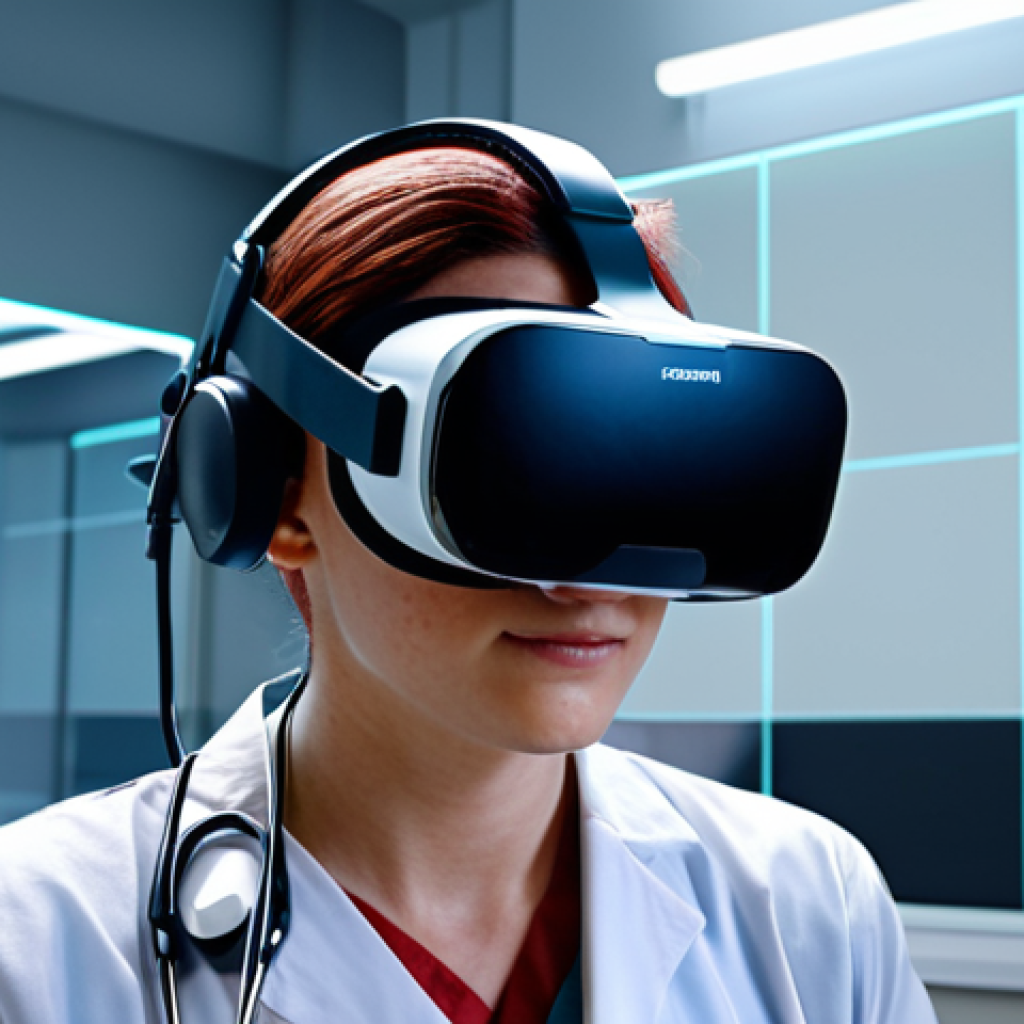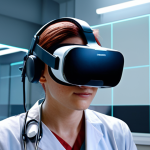Okay, here’s the blog introduction:Have you ever imagined stepping into a world where the line between reality and the digital realm blurs? That’s precisely what extended reality (XR) promises.
From immersive gaming experiences to revolutionizing how we learn and work, XR is poised to reshape our lives. As someone who’s been following the tech scene, I’m seeing a huge surge in XR applications, fueled by advancements in AI and 5G connectivity.
It’s not just hype, either; companies are investing billions, and the potential impact is enormous. XR is not just about entertainment, it is solving real-world problems across various industries.
Let’s dive deeper to understand extended reality a little more accurately!
## The Evolving Landscape of XR TechnologyThe realm of extended reality is continuously shifting, and understanding these changes is crucial for anyone looking to invest, develop, or simply stay informed.
What was cutting-edge last year might be commonplace now, with new breakthroughs emerging at an accelerating rate. It’s less about individual gadgets and more about how these technologies are interwoven into our daily lives.
Think about how AR apps have transformed shopping, allowing you to virtually “try on” clothes or see how furniture fits in your living room. Or how VR is being used to provide realistic training simulations for surgeons, pilots, and even astronauts.
This evolution is fueled by advancements in hardware, software, and the increasing affordability of these technologies.
The Rise of XR Cloud Platforms

The cloud is playing an increasingly vital role in XR, enabling developers to create more immersive and interactive experiences. By leveraging the power of cloud computing, XR applications can offload heavy processing tasks, resulting in better performance and reduced latency.
We’re already seeing platforms that allow users to stream high-fidelity VR experiences to their headsets without requiring powerful local hardware. I’ve personally tested several of these cloud-based XR platforms, and the responsiveness and visual quality have been surprisingly impressive.
The Impact of 5G and Wi-Fi 6E on XR
High-speed, low-latency connectivity is essential for delivering seamless XR experiences. With the rollout of 5G networks and the adoption of Wi-Fi 6E, we’re seeing a significant improvement in the quality and reliability of XR applications.
These technologies enable real-time interactions, multiplayer experiences, and the streaming of high-resolution content without lag or interruption. From my perspective, this improved connectivity is a game-changer for XR, unlocking new possibilities for remote collaboration, immersive entertainment, and more.
XR Applications Beyond Gaming
While gaming is often the first thing that comes to mind when people think of XR, the technology has a wide range of applications across various industries.
From healthcare to education to manufacturing, XR is transforming the way we work, learn, and interact with the world around us. I’ve been particularly impressed by how XR is being used to improve training and simulation, allowing individuals to practice complex tasks in a safe and controlled environment.
XR in Healthcare: Revolutionizing Training and Treatment
In healthcare, XR is being used to train surgeons, diagnose diseases, and provide therapeutic interventions. VR simulations allow medical students to practice complex procedures without the risk of harming patients, while AR apps can overlay real-time data onto a patient’s body to assist with diagnosis and treatment.
I’ve seen firsthand how XR is helping to improve patient outcomes and reduce the cost of healthcare.
XR in Education: Creating Immersive Learning Experiences
XR is transforming education by creating immersive and engaging learning experiences. Students can explore historical sites, dissect virtual organisms, and participate in interactive simulations that bring concepts to life.
I’ve observed that XR-based learning can significantly improve student engagement and retention, making education more effective and enjoyable.
The Challenges and Opportunities of XR Adoption
Despite its immense potential, XR adoption faces several challenges. High costs, technical limitations, and a lack of user awareness are some of the barriers that need to be overcome.
However, as technology improves and prices come down, we’re seeing a growing number of individuals and organizations embrace XR. The opportunities are vast, and those who are willing to invest in XR now stand to gain a significant competitive advantage.
Addressing the Cost Barrier
One of the biggest challenges facing XR adoption is the high cost of hardware and software. VR headsets, AR glasses, and the necessary computing power can be expensive, making it difficult for individuals and small businesses to get started.
However, prices are coming down, and there are now more affordable options available. I’ve found that exploring different financing options, such as leasing or subscription models, can help to make XR more accessible.
Overcoming Technical Limitations
XR technology is still evolving, and there are several technical limitations that need to be addressed. Issues such as motion sickness, limited field of view, and low resolution can detract from the user experience.
However, researchers and developers are working tirelessly to overcome these limitations, and we’re seeing steady improvements in XR technology.
Ethical Considerations in the Age of XR
As XR becomes more prevalent, it’s important to consider the ethical implications of this technology. Issues such as privacy, data security, and the potential for addiction need to be addressed.
We must ensure that XR is used responsibly and ethically, and that individuals are protected from harm.
Privacy and Data Security
XR applications often collect vast amounts of data about users, including their movements, gaze direction, and even their emotional responses. This data can be used for a variety of purposes, such as targeted advertising, but it also raises concerns about privacy and data security.
It’s crucial that XR developers implement strong security measures to protect user data and that users are given control over their privacy settings.
The Potential for Addiction
XR experiences can be highly immersive and engaging, which can lead to addiction in some individuals. It’s important to use XR in moderation and to be aware of the potential risks of overuse.
Parents should monitor their children’s XR usage and set limits as necessary.
XR and the Future of Work
XR is poised to transform the way we work, enabling remote collaboration, virtual training, and enhanced productivity. Imagine attending a meeting in a virtual conference room, where you can interact with colleagues from all over the world as if you were in the same physical space.
Or using AR glasses to guide you through complex assembly tasks, reducing errors and improving efficiency. XR has the potential to revolutionize the workplace and create new opportunities for workers.
Remote Collaboration and Communication
XR is making remote collaboration more seamless and engaging. Virtual meeting spaces allow teams to interact with each other in a more natural and immersive way, fostering better communication and collaboration.
I’ve participated in several XR-based meetings, and I’ve found that they can be just as productive as in-person meetings, if not more so.
Virtual Training and Skill Development
XR is revolutionizing training and skill development by providing realistic and interactive simulations. Employees can practice complex tasks in a safe and controlled environment, without the risk of making costly mistakes.
This can lead to improved performance, reduced training costs, and a more skilled workforce.
Investing in the XR Revolution
For those looking to get involved in the XR revolution, there are numerous opportunities to invest in the technology, develop applications, or simply stay informed.
From startups to established tech giants, companies are pouring billions of dollars into XR, and the potential for growth is enormous. Whether you’re an investor, a developer, or simply an enthusiast, there’s never been a better time to get involved in XR.
Identifying Promising XR Companies
When investing in XR, it’s important to identify companies that have a strong vision, a solid team, and a clear path to success. Look for companies that are developing innovative technologies, addressing real-world problems, and have a strong track record of execution.
Exploring XR Development Opportunities
For developers, XR offers a wealth of opportunities to create innovative applications and experiences. From gaming to education to healthcare, there’s a demand for talented XR developers across various industries.
If you’re a developer, consider learning XR development tools and platforms, such as Unity or Unreal Engine. Here is a table that summarizes the key points discussed above:
| Aspect of XR | Key Trends | Challenges | Opportunities |
|---|---|---|---|
| Technology Evolution | Cloud platforms, 5G/Wi-Fi 6E, enhanced hardware | High costs, technical limitations | Improved performance, accessibility, and user experience |
| Applications | Healthcare training, education, remote collaboration | Lack of awareness, ethical considerations | Revolutionizing industries, creating new job opportunities |
| Ethical Considerations | Privacy, data security, potential for addiction | Need for responsible and ethical use | Protecting users, ensuring responsible development |
| Future of Work | Remote collaboration, virtual training, enhanced productivity | Integration into existing workflows | Transforming the workplace, creating new opportunities |
| Investment | Identifying promising companies, exploring development opportunities | Market volatility, competition | Significant growth potential, early-mover advantage |
The information provided is solely for informational purposes and should not be construed as financial or investment advice. Always conduct thorough research and consult with a qualified professional before making any investment decisions.
The pace of XR technology is breathtaking, and while it presents challenges, the opportunities for innovation and transformation across industries are immense.
Staying informed and adaptable is key to navigating this ever-evolving landscape. Whether you’re developing new applications, exploring investment opportunities, or simply curious about the possibilities, the future of XR is undeniably exciting.
Concluding Remarks
As we stand at the cusp of a new era powered by XR, the potential for innovation and societal change is truly remarkable. The advancements in XR technology are opening doors to experiences that were once confined to the realm of science fiction.
The ongoing evolution of XR promises to redefine how we learn, work, and connect with each other, paving the way for a future where the digital and physical worlds converge in unprecedented ways. Embracing these advancements will be crucial for individuals and organizations alike to thrive in this transformative landscape.
The journey into the world of XR is filled with opportunities for growth, creativity, and positive impact. As technology continues to evolve, so too will the possibilities for what we can achieve with XR, making it an exciting and promising field to watch.
Useful Information
1. Follow XR Industry Experts: Stay updated on the latest trends by following influential bloggers, analysts, and researchers in the XR field.
2. Join XR Communities: Engage with fellow enthusiasts and professionals in online forums, social media groups, and industry events.
3. Attend XR Conferences and Trade Shows: Immerse yourself in the XR world by attending industry events to network, learn, and experience the latest technologies firsthand.
4. Experiment with XR Apps and Devices: Try out different XR applications and devices to gain firsthand experience and understand the technology’s capabilities.
5. Consider Certification Programs: Improve your skillset and credibility by obtaining certifications in XR development, design, or related fields.
Key Takeaways
XR technology is rapidly evolving, driven by advancements in hardware, software, and connectivity.
XR has diverse applications across healthcare, education, manufacturing, and entertainment.
Addressing challenges like cost, technical limitations, and ethical considerations is essential for wider adoption.
XR is poised to transform the future of work by enabling remote collaboration, virtual training, and enhanced productivity.
Investing in XR requires careful consideration of company vision, team strength, and market opportunity.
Frequently Asked Questions (FAQ) 📖
Q: What’s the biggest difference between VR,
A: R, and MR, and why should I care? A1: Okay, so imagine you’re sitting on your couch. VR (Virtual Reality) completely replaces your view with a digital world – think strapping on a headset and suddenly you’re battling dragons or exploring Mars.
AR (Augmented Reality), on the other hand, overlays digital information onto your real-world view, like Pokemon GO on your phone or seeing furniture in your living room using an app.
MR (Mixed Reality) is kind of the best of both worlds, blending digital objects into your real environment in a way that they can interact with each other – like, you could have a virtual cat that sits on your real-world couch.
You should care because VR is amazing for immersive entertainment and training simulations, AR can make everyday tasks easier and more engaging, and MR is opening up completely new possibilities for collaboration and design in professional settings.
Personally, I think MR’s ability to create interactive experiences is going to be a game-changer.
Q: I keep hearing about “the metaverse.” Is XR the same thing, or is it something different?
A: That’s a great question! Think of XR as the underlying technology that enables the metaverse. The metaverse is essentially a persistent, shared virtual world (or set of worlds) where people can interact with each other, digital objects, and even virtual versions of real-world places.
XR, with its VR, AR, and MR components, provides the interfaces and experiences to access and engage in the metaverse. So, while they’re not the same, XR is crucial for building and experiencing the metaverse.
It’s like saying the internet is the network, and a website is one of the things you can do on the internet. In my experience, a lot of folks get tripped up on the terminology, but once you understand that XR is the tech and the metaverse is the destination, it makes a lot more sense.
Q: This all sounds really expensive. Do I need to drop a ton of money to try out XR?
A: Not necessarily! While high-end VR headsets and MR devices can definitely set you back a pretty penny, there are a lot of affordable ways to dip your toes into XR.
Google Cardboard or similar smartphone-based VR viewers are super cheap and can give you a basic VR experience. AR apps are readily available on most smartphones and tablets, so you can start experimenting with augmented reality right away.
I’ve even seen libraries and community centers start offering VR experiences to the public, so you could potentially try it out for free. And honestly, even the mid-range headsets are becoming more affordable over time.
Don’t let the high-end stuff scare you off; there are plenty of ways to explore XR without breaking the bank. I started with a cheap phone-based VR headset, and that’s what got me hooked!
📚 References
Wikipedia Encyclopedia



